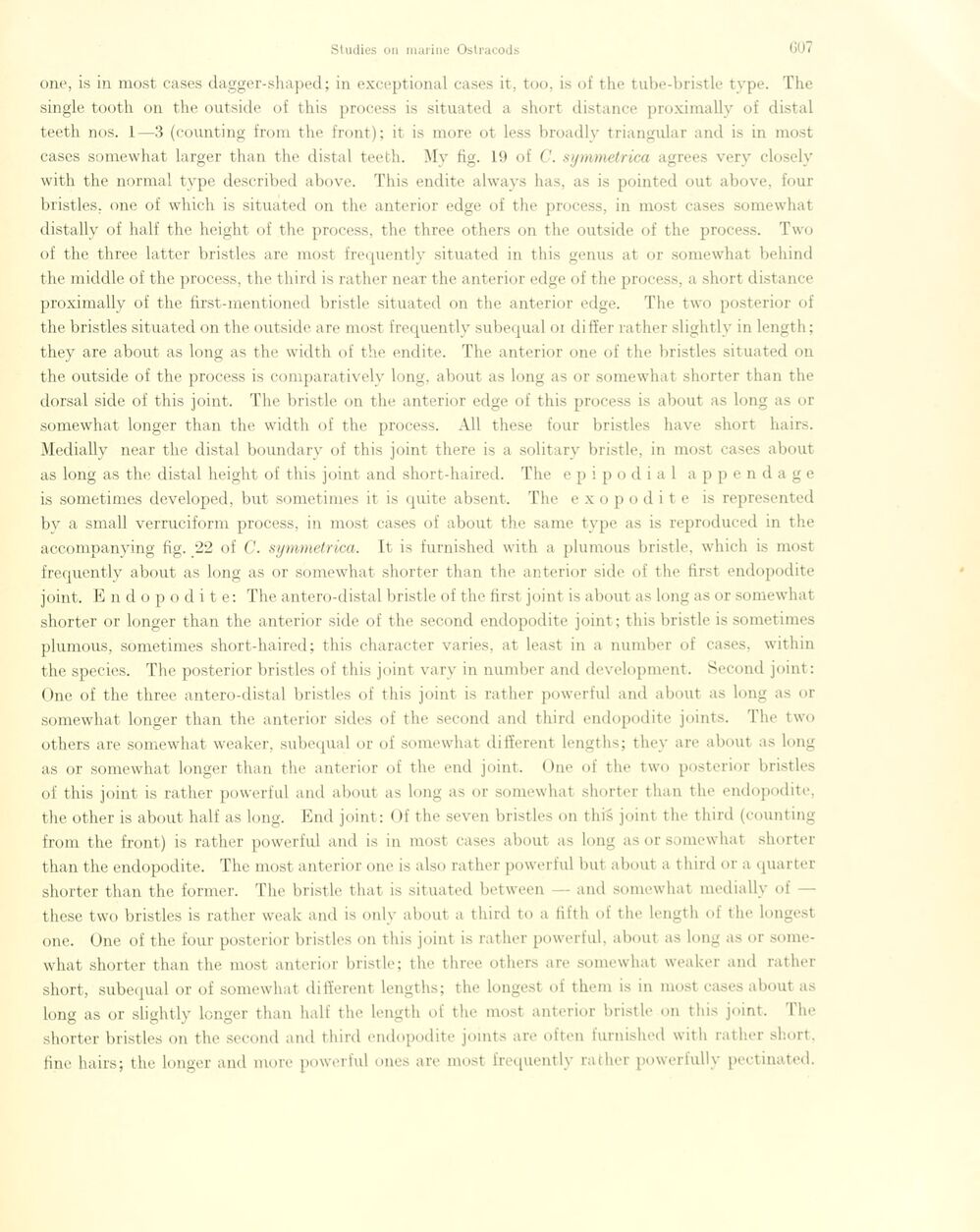
Full resolution (JPEG) - On this page / på denna sida - Sidor ...

<< prev. page << föreg. sida << >> nästa sida >> next page >>
Below is the raw OCR text
from the above scanned image.
Do you see an error? Proofread the page now!
Här nedan syns maskintolkade texten från faksimilbilden ovan.
Ser du något fel? Korrekturläs sidan nu!
This page has never been proofread. / Denna sida har aldrig korrekturlästs.
one, is in most cases dagger-shaped; in exceptional cases it, too, is of the tube-bristle type. The
single tooth on the outside of this process is situated a short distance proximallv of distal
teetli nos. 1—3 (counting front the front); it is more ot less broadly triangulär and is in most
cases somewhat larger than the distal teeth. My fig. 19 of C. symmetrica agrees very closely
with the normal type described above. This endite always lias, as is pointed out above, four
bristles. one of which is situated on the anterior edge of the process, in most cases somewhat
distally of half the height of the process, the three others on the outside of the process. Two
of the three latter bristles are most frequently situated in this genus at or somewhat behind
the middle of the process, the third is rather near the anterior edge of the process, a short distance
proximally of the first-mentioned bristle situated on the anterior edge. The two posterior of
the bristles situated on the outside are most frequently subequal oi differ rather slightlv in length;
they are about as long as the width of the endite. The anterior one of the bristles situated on
the outside of the process is comparatively long, about as long as or somewhat shorter than the
dorsal side of this joint. The bristle on the anterior edge of this process is about as long as or
somewhat longer than the width of the process. All these four bristles have short hairs.
Medially near the distal boundary of this joint there is a solitary bristle, in most cases about
as long as the distal height of this joint and short-haired. The epipodial a p p e n d a g e
is sometimes developed, but sometimes it is quite absent. The e x o p o d i t e is represented
by a small verruciform process, in most cases of about the same type as is reproduced in the
accompanying fig. 22 of C. symmetrica. It is furnished with a plumous bristle, which is most
frequently about as long as or somewhat shorter than the anterior side of the first endopodite
joint. Endopodite: The antero-distal bristle of the first joint is about as long as or somewhat
shorter or longer than the anterior side of the second endopodite joint; this bristle is sometimes
plumous, sometimes short-haired; this character varies, at least in a number of cases, within
the species. The posterior bristles of this joint vary in number and development. Second joint:
One of the three antero-distal bristles of this joint is rather powerful and about as long as or
somewhat longer than the anterior sides of the second and third endopodite joints. The two
others are somewhat weaker, subequal or of somewhat different lengths; they are about as long
as or somewhat longer than the anterior of the end joint. One of the two posterior bristles
of this joint is rather powerful and about as long as or somewhat shorter than the endopodite,
the other is about half as long. End joint: Of the seven bristles on this joint the third (counting
from the front) is rather powerful and is in most cases about as long as or somewhat shorter
than the endopodite. The most anterior one is also rather powerful but about a third or a quarter
shorter than the former. The bristle that is situated between — and somewhat medially of
these two bristles is rather weak and is only about a third to a fifth of the length of the longest
one. Une of the four posterior bristles on this joint is rather powerful, about as long as or
somewhat shorter than the most anterior bristle; the three others are somewhat weaker and rather
short, subequal or of somewhat different lengths; the longest of them is in most cases about as
long as or slightly longer than half the length of the most anterior bristle on this joint. Plie
shorter bristles on the second and third endopodite joints are often furnished with rather short,
line hairs; the longer and more powerful ones are most frequently rather powerfully pectinated.
<< prev. page << föreg. sida << >> nästa sida >> next page >>